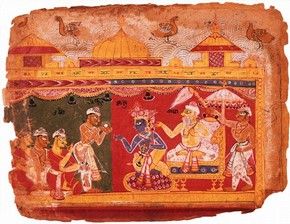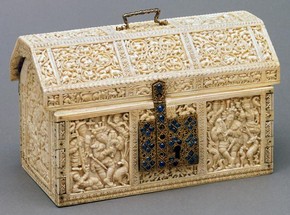The Mughal Empire was an imperial power in the Indian subcontinent from about 1526 to 1757. At the height of their power in the late 17th and early 18th centuries, they controlled most of the subcontinent - extending from Bengal in the east to Balochistan in the west, Kashmir in the north to the Kaveri basin in the south. The V&A's collection of Mughal court arts includes some of the most important pieces in the world.
-
India before the Mughals

Manuscript illustration from the Bhagavata Purana, 1525. Museum no. IS.2-1977
Before the Mughal invasion of 1526, the north of the subcontinent was divided up into several independent Hindu and Muslim kingdoms. Many of these were culturally very sophisticated, and paintings and architecture from many different areas survive to illustrate this.
Hindu painting at this time in northern India dealt mainly with mythical and religious subjects such as the exploits of the god Krishna. Real people were not depicted in Indian painting at this time. Colours were bright and flat, with no use of shading or perspective, and figures were highly stylised.
Another important group of patrons of medieval Indian manuscript painting was the Jain merchant community of western India.
Jainism is a religion similar to Buddhism in its commitment to non-violence and its lack of an individual deity. Because agriculture involves the killing of tiny insects and animals, Jains have always favoured commercial professions. Wealthy Jain businessmen were (and still are) pious patrons of devotional art, and many of the most beautiful manuscripts and temples of the pre-Mughal period were commissioned by them.
India before the Mughals

Manuscript illustration from the Bhagavata Purana, 1525. Museum no. IS.2-1977
Before the Mughal invasion of 1526, the north of the subcontinent was divided up into several independent Hindu and Muslim kingdoms. Many of these were culturally very sophisticated, and paintings and architecture from many different areas survive to illustrate this.
Hindu painting at this time in northern India dealt mainly with mythical and religious subjects such as the exploits of the god Krishna. Real people were not depicted in Indian painting at this time. Colours were bright and flat, with no use of shading or perspective, and figures were highly stylised.
Another important group of patrons of medieval Indian manuscript painting was the Jain merchant community of western India.
Jainism is a religion similar to Buddhism in its commitment to non-violence and its lack of an individual deity. Because agriculture involves the killing of tiny insects and animals, Jains have always favoured commercial professions. Wealthy Jain businessmen were (and still are) pious patrons of devotional art, and many of the most beautiful manuscripts and temples of the pre-Mughal period were commissioned by them.
The beginnings of trade with Europe

'The Robinson Casket', around 1557, ivory. Museum no. IS.41-1980
The first contact with modern Europe came when Portuguese traders reached India in the wake of Vasco de Gama’s discovery of the route around the Cape of Good Hope in 1498.
The Portuguese set up trading posts first on the west coast and then in Bengal. Spices were their main interest, but magnificent embroidered textiles were also made by Bengali craftsmen for sale in Portugal.
Furniture based on European styles made with local materials was produced both for export and for the Portuguese communities in India.
This amalgamation of local materials and craftsmanship with the taste of foreign patrons can be seen repeatedly in the objects on show in the V&A's South Asia gallery, especially in those made for the British in the eighteenth and nineteenth centuries.
fonte: @edisonmariotti #edisonmariotti
http://www.vam.ac.uk/content/articles/i/india-before-the-mughals/
http://www.vam.ac.uk/content/articles/i/india-before-the-mughals/
Cultura e conhecimento são ingredientes essenciais para a sociedade.
A cultura é o único antídoto que existe contra a ausência de amor.
Vamos compartilhar.
--br
Iniciadas as obras do Mughal Museum de David Chipperfield na Índia
Foram inciadas as obras do Mughal Museum, projetado por David Chipperfield em Agra, Índia. Parte de um masterplan liderado por Archohm, que inclui o Taj Orientation Center e o Agra Heritage Center, o projeto oferecerá 5.200 metros quadrados de espaços para exposições permanentes e temporárias inteiramente "dedicados à estória e cultura dos Mughals, uma dinastia que dominou a região norte da Índia por mais de três séculos", comentou o escritório.
A obra tem conclusão prevista para o final de 2017.
Foram inciadas as obras do Mughal Museum, projetado por David Chipperfield em Agra, Índia. Parte de um masterplan liderado por Archohm, que inclui o Taj Orientation Center e o Agra Heritage Center, o projeto oferecerá 5.200 metros quadrados de espaços para exposições permanentes e temporárias inteiramente "dedicados à estória e cultura dos Mughals, uma dinastia que dominou a região norte da Índia por mais de três séculos", comentou o escritório.
A obra tem conclusão prevista para o final de 2017.



Nenhum comentário:
Postar um comentário